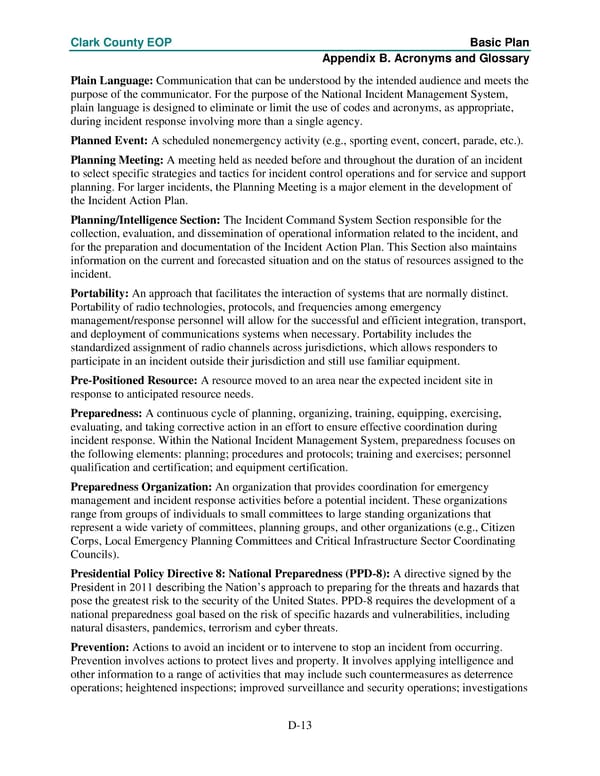Clark County EOP Basic Plan Appendix B. Acronyms and Glossary Plain Language: Communication that can be understood by the intended audience and meets the purpose of the communicator. For the purpose of the National Incident Management System, plain language is designed to eliminate or limit the use of codes and acronyms, as appropriate, during incident response involving more than a single agency. Planned Event: A scheduled nonemergency activity (e.g., sporting event, concert, parade, etc.). Planning Meeting: A meeting held as needed before and throughout the duration of an incident to select specific strategies and tactics for incident control operations and for service and support planning. For larger incidents, the Planning Meeting is a major element in the development of the Incident Action Plan. Planning/Intelligence Section: The Incident Command System Section responsible for the collection, evaluation, and dissemination of operational information related to the incident, and for the preparation and documentation of the Incident Action Plan. This Section also maintains information on the current and forecasted situation and on the status of resources assigned to the incident. Portability: An approach that facilitates the interaction of systems that are normally distinct. Portability of radio technologies, protocols, and frequencies among emergency management/response personnel will allow for the successful and efficient integration, transport, and deployment of communications systems when necessary. Portability includes the standardized assignment of radio channels across jurisdictions, which allows responders to participate in an incident outside their jurisdiction and still use familiar equipment. Pre-Positioned Resource: A resource moved to an area near the expected incident site in response to anticipated resource needs. Preparedness: A continuous cycle of planning, organizing, training, equipping, exercising, evaluating, and taking corrective action in an effort to ensure effective coordination during incident response. Within the National Incident Management System, preparedness focuses on the following elements: planning; procedures and protocols; training and exercises; personnel qualification and certification; and equipment certification. Preparedness Organization: An organization that provides coordination for emergency management and incident response activities before a potential incident. These organizations range from groups of individuals to small committees to large standing organizations that represent a wide variety of committees, planning groups, and other organizations (e.g., Citizen Corps, Local Emergency Planning Committees and Critical Infrastructure Sector Coordinating Councils). Presidential Policy Directive 8: National Preparedness (PPD-8): A directive signed by the President in 2011 describing the Nation’s approach to preparing for the threats and hazards that pose the greatest risk to the security of the United States. PPD-8 requires the development of a national preparedness goal based on the risk of specific hazards and vulnerabilities, including natural disasters, pandemics, terrorism and cyber threats. Prevention: Actions to avoid an incident or to intervene to stop an incident from occurring. Prevention involves actions to protect lives and property. It involves applying intelligence and other information to a range of activities that may include such countermeasures as deterrence operations; heightened inspections; improved surveillance and security operations; investigations D-13
 Emergency Operations Plan Page 116 Page 118
Emergency Operations Plan Page 116 Page 118